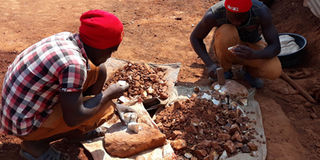Small yet impactful: Case of artisanal gold miners

Groups of youth work in twos or more while extracting gold in Moroto. PHOTOS | HALIMA ABDALLAH
What you need to know:
- Gold mining in Uganda is largely secretive and artisan. However, the entry of immigrant miners, especially from Tanzania and DR Congo is changing the landscape and promises better results due to use of improved technology.
The sound of the hammers vibrate from a distance as youth cleave away on rocks.
Groups of two or more youth form much of the working patterns here, hammering stones and rolling machines here and there.
In one corner are two youthful men milling ore into fine sandy dust that is later filled in cyanidation tanks to be leached.
This is part of the process that forms gold extraction.
Gold is one of the most sought after minerals, largely extracted by artisanal miners in Uganda.
A mini study conducted by Daily Monitor indicates youth are the biggest composition of gold extraction with many of them being immigrants from Tanzanian.
Most of them, according to the study, arrived in Uganda in 2017 after a clampdown and shutdown of a number of mines in Tanzania.
Tanzania had around the time sought to review its mining legal regime to allow improved national participation.
Under the reviewed law, government owns 16 per cent stake in all mineral rights and shares into profits at 50 per cent.
The review coincided with Uganda’s mineral rush thus migrants found a home in a number of mines, especially in places such as Busia - a border district with Kenya.
“There is a gold boom in this country and miners from around the region are coming into Uganda, for us Tanzanians are coming as technical persons,” says Robert Wanyama, the Sama Processing Plant in-charge of laboratory and solutions, in Busia.
Sama Processing Plant recycles tailings-remains of soil after initial gold extraction. The process ensures that every gold is extracted before the waste is discarded.
The process which is highly chemicalised uses water, mercury and cyanide in a controlled manner to eliminate environmental and health hazards.
The technology was largely introduced by immigrants from Tanzania and has indeed boosted production from what used to be waste by between two and three kilogrammes annually, according to miners.
“Before they came, [Tanzanians], we did not know what to do with heaps waste after first time extraction. But now, tailings have become highly competitive. We no longer have tailings dumped on river banks because they have value,” says Wanyama.
Ugandan miners largely harvest gold using crude methods that involve washing in basins.
The process, which is largely manual, makes miners come into direct contact with chemicals, which have a potential to impact their health.
Therefore, the arrival of immigrant miners, has impacted gold mining and is building capacity for better yield.
Context
Uganda first experienced the mineral rush in 1926 when copper was discovered in Kasese.
The rush was later accelerated by the discovery of gold in Buwehju, west of Uganda in 1939.
Mining expeditions are not a new affair. In fact, mining in Uganda dates back around 1919, when colonialists started extensive exploration for mineral resources around the country.
Between 1955 and 1976, mining copper thrived with a remarkable contribution that led to the construction of the railway network to Kasese.
At the time, mining contributed more than 30 per cent to growth domestic product.
However, civil unrest brought the industry to a standstill and it is only beginning to pick up the pieces.
Currently, mining contributes a paltry 0.3 per cent, far below the target of 7 per cent by 2020 according to National Development Plan II.

The introduction of machines by immigrant artisanal miners, especially from Tanzania is improving extraction.
The unrest also opened the space for artisanal small scale miners that continue to thrive today.
Data from the Department of Geological Survey and Mines in the Ministry of Energy, indicates that Uganda has about 800,000 artisanal small scale miners employed directly.
However, many of these are not licensed given that there are only 400 mineral rights in exploration and retention or mining leases.
According to the International Labour Organisation, in recent years artisanal and small-scale mining accounted for between 15 and 20 per cent of the world’s non-fuel mineral production.
Extent of involvement
Both artisanal small scale miners and large scale miners, are involved in iron ore, tungsten, tantalum, coltan, limestone, salt, kaolin, Bentonite, Kaolin, limestone, gypsum and development of minerals (building materials).
Building minerals, for example, generate on average $350m to artisanal small scale miners according to Department of Geological Survey and Mines.
Government data shows that 95 per cent of Department of Geological Survey and Mines are unlicensed, but pay fees to local governments and land owners.
Majority ASM prefer gold owing to the ease of extraction and processing the ore to the final gold resource. Importantly also, gold has high values and ready markets.
Our study in mineral-rich districts of Moroto and Busia, both in eastern Uganda and Mubende in south western Uganda, indicates that immigrant miners from DR Congo, Kenya, Rwanda, Burundi and Tanzania have found a new income source besides the natives who had been involved in the business though at a relatively crude level.
However, what has been more benefiting is the amount of skills and technology that they come with, which according to Hassan Odima, a gold miner “are important because they have taught us how to use tanks”.
Turkanas from Kenya, for example, trade in gold in Karamoja but are also involved in limestone that is hewing in Tororo.
However, this has not been without conflict.
For instance, the Turkanas were recently forced to return to Kenya after a pricing dispute.
Such disputes are a main stay but because the mines have a semblance of leadership, they are resolved.
Amending the law
Currently, Uganda is in the process of amending the Mining Act 2003 to legalise operations of artisanal small scale miners, which is illegal.
The amendment will make artisanal small scale miners a preserve for nationals only operating under location licences.
The proposed law will also make it mandatory for miners to own national identification cards before licences are issued.
The Department of Geological Survey and Mines estimates that artisanal small scale miners have the potential to increase annual gross domestic product by more than 3 per cent.
Their operations are currently inhibited by limited access to mineral rights, credit, technology, access to geological data and conflict with large scale operators.
Mining as a side income
Many of the artisanal miners have no prior experience in mining. They seem to be motivated by the desire to find an alternative source of income.
For instance, a Turkana woman living at Rupa sub-county in Moroto District narrates her husband’s journey to look for pasture for their cattle changed the course into gold mining.
My husband came here to graze our cattle. But he found gold mining and he is now involved,” she says.
The woman and her husband, are part of a group that crosses into Uganda to graze cattle but gets involved in gold mining as a side hustle.
The mining in Rupa is largely crude with miners using the mostly the washing method to extract gold.




